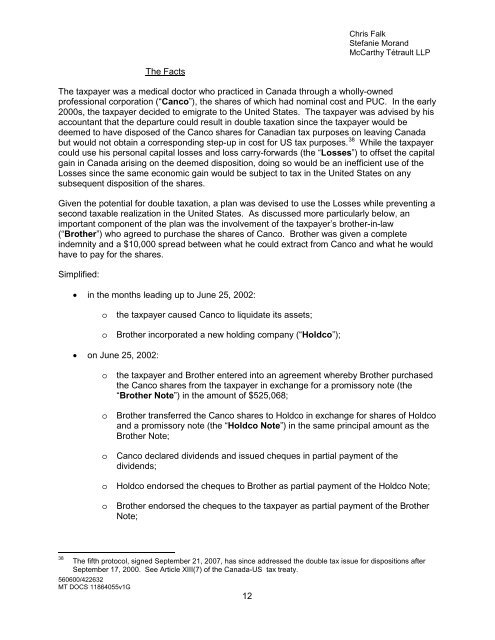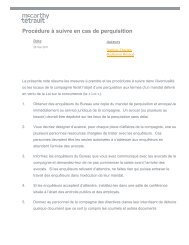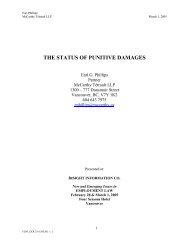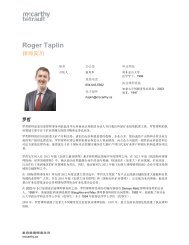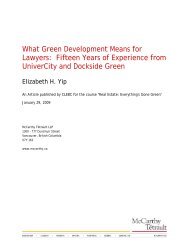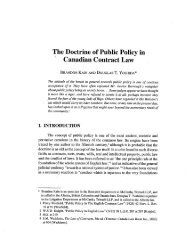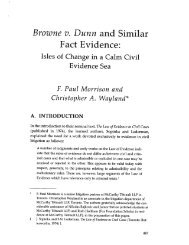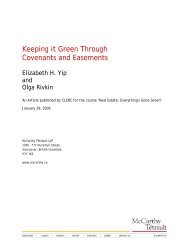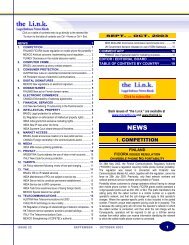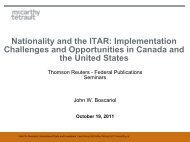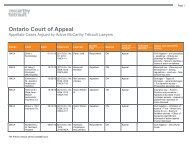Presentation Material - McCarthy Tétrault
Presentation Material - McCarthy Tétrault
Presentation Material - McCarthy Tétrault
You also want an ePaper? Increase the reach of your titles
YUMPU automatically turns print PDFs into web optimized ePapers that Google loves.
Chris Falk<br />
Stefanie Morand<br />
<strong>McCarthy</strong> Tétrault LLP<br />
The Facts<br />
The taxpayer was a medical doctor who practiced in Canada through a wholly-owned<br />
professional corporation (“Canco”), the shares of which had nominal cost and PUC. In the early<br />
2000s, the taxpayer decided to emigrate to the United States. The taxpayer was advised by his<br />
accountant that the departure could result in double taxation since the taxpayer would be<br />
deemed to have disposed of the Canco shares for Canadian tax purposes on leaving Canada<br />
but would not obtain a corresponding step-up in cost for US tax purposes. 38 While the taxpayer<br />
could use his personal capital losses and loss carry-forwards (the “Losses”) to offset the capital<br />
gain in Canada arising on the deemed disposition, doing so would be an inefficient use of the<br />
Losses since the same economic gain would be subject to tax in the United States on any<br />
subsequent disposition of the shares.<br />
Given the potential for double taxation, a plan was devised to use the Losses while preventing a<br />
second taxable realization in the United States. As discussed more particularly below, an<br />
important component of the plan was the involvement of the taxpayer’s brother-in-law<br />
(“Brother”) who agreed to purchase the shares of Canco. Brother was given a complete<br />
indemnity and a $10,000 spread between what he could extract from Canco and what he would<br />
have to pay for the shares.<br />
Simplified:<br />
• in the months leading up to June 25, 2002:<br />
o<br />
o<br />
the taxpayer caused Canco to liquidate its assets;<br />
Brother incorporated a new holding company (“Holdco”);<br />
• on June 25, 2002:<br />
o<br />
o<br />
o<br />
o<br />
o<br />
the taxpayer and Brother entered into an agreement whereby Brother purchased<br />
the Canco shares from the taxpayer in exchange for a promissory note (the<br />
“Brother Note”) in the amount of $525,068;<br />
Brother transferred the Canco shares to Holdco in exchange for shares of Holdco<br />
and a promissory note (the “Holdco Note”) in the same principal amount as the<br />
Brother Note;<br />
Canco declared dividends and issued cheques in partial payment of the<br />
dividends;<br />
Holdco endorsed the cheques to Brother as partial payment of the Holdco Note;<br />
Brother endorsed the cheques to the taxpayer as partial payment of the Brother<br />
Note;<br />
38<br />
The fifth protocol, signed September 21, 2007, has since addressed the double tax issue for dispositions after<br />
September 17, 2000. See Article XIII(7) of the Canada-US tax treaty.<br />
560600/422632<br />
MT DOCS 11864055v1G<br />
12


